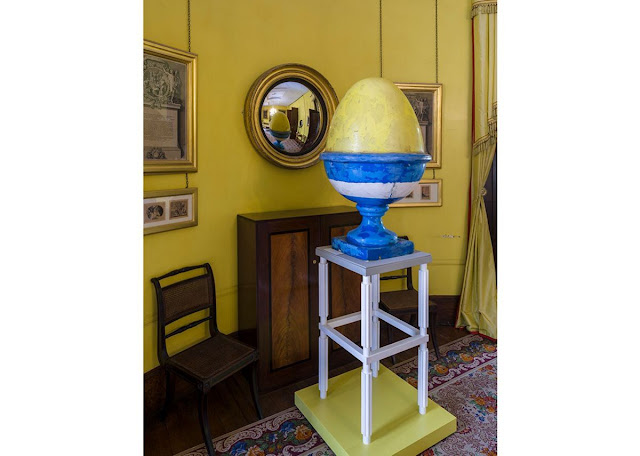I went for a walk in Poundbury, in Dorset. It wasn’t completely awful but it was weird, and in fact bits of it were pretty awful.
Poundbury, you know, is Prince Charles’s utopian stab at urban development, planned by his tame architectural theorist Leon Krier. Neither of these dudes lives in Poundbury, you’ll be surprised to hear. Krier does drawings like this:
Poundbury gets compared to Disneyland and Stepford (where the wives comes from) but I kept thinking of The Prisoner - not the actual Portmeirion designed by Clough Williams-Ellis, the location where the tv show was filmed, but the fictional village – a place so calm and tranquil and well-ordered, you just knew something absolutely terrible was about to happen.
There is a town square of sorts in Poundbury, with a statue of the late Queen Mum – Krier designed the base.

This is Queen Mother Square. Nearby is a pub named after Prince Charles’s wife - The Duchess of Cornwall Inn (what woman doesn’t want to have a pub named after her?), and just over the way, opposite the Waitrose, is a block of luxury flats that looks, deliberately, like a faux Buckingham Place, because you know, the real original Buckingham Place looks so awesome.

This is Queen Mother Square. Nearby is a pub named after Prince Charles’s wife - The Duchess of Cornwall Inn (what woman doesn’t want to have a pub named after her?), and just over the way, opposite the Waitrose, is a block of luxury flats that looks, deliberately, like a faux Buckingham Place, because you know, the real original Buckingham Place looks so awesome.
Incidentally, as you see, there is no grass in this public square, no benches, no identifiable pavements, nowhere to hang out. There is also very little separation between pedestrians and cars, though there are some bollards protecting the statue. They might also protect pedestrians, but that’s obviously not their prime reason for existing. The walker would do well to keep moving.
This lack of pedestrian friendliness comes as something of a surprise. Poundbury was supposedly built to be a super-pedestrian-friendly place. The Prince would have you believe he’s a great believer in walking. In 2004, he set down his ten design principles. Number five asks for: “The creation of well-designed enclosures. Rather than clusters of separate houses set at jagged angles, spaces that are bounded and enclosed by buildings are not only more visually satisfying, they encourage walking and feel safer.”
In this he’s echoing Leon Krier who posits a city made up of quarters or quadrants, the centers of which can be crossed in the course of a ten-minute walk. For most of us, that’s no more than a half-mile stroll, which seems a little unambitious, and just pitiful for anybody who enjoys walking in a big city.
In fact one of the first things this walker noticed was just how car-friendly Poundbury seemed, perhaps because, at the moment there’s a great deal of free parking. However, since the population is scheduled to double in size in the next few years, a parking spot adjacent to the Duchess of Cornwall Inn may be increasingly hard to come by.
Along with this, I noticed just how many garages there are in Poundbury – huge numbers, most of them not attached to the dwelling of the car owner. In fact there were quite a few examples of flats built on top of one or more garages belonging to other people, the disadvantage of which seem utterly obvious.
There are a few exceptions, but the vast majority of the garage doors are painted plain black. Now, I’m not suggesting than selecting the paint color for your garage door is an inalienable freedom or a great mark of self-expression, but my own feeling is that I’d prefer any color so long as it’s not plain black. I also thought those plain black “canvases” might represent a challenge and a provocation to the youth of Poundbury, but apparently not, and that may be because Poundbury the youth is in such short supply.
Of course I saw other people walking, some with dogs.
I also saw a couple of cats, of which this is one
The place was clean, it was safe, it was nice, and I’m not an idiot, I’m not against any of those things,
but oh boy did my heart leap up when I eventually found the council estate.
The only graffiti I saw were there or thereabouts, and I’m no snowflake when It comes to graffiti, and these was pretty rubbish in themselves but they came as a kind of relief.
These acts of self-expression were on one side of this classical temple type thing, which was actually an electricity substation.
The graffiti were on the side that looked towards the sports ground and away from the council estate, which I suppose was basicalily a good thing. And this “social housing” had so much that Poundbury houses didn’t have: life, an unruliness, a genuine if sometimes naff urge for eccentricity and self-expression. There were front gardens for instance – there were very few of those in Poundbury proper.
Here, some of them had been paved over to accommodate a car, some were carefully tended with topiary, some had am ugly heap of rubbish on the grass but at least the residents had made their own choice of paint color for the garage doors.
But the thing that made the whole Poundbury walking expedition worthwhile for me, was this sign in the front garden of a house evidently belonging to a small local businessman.
Just possibly Poundbury is more diverse than many people think, or want it to be.







































